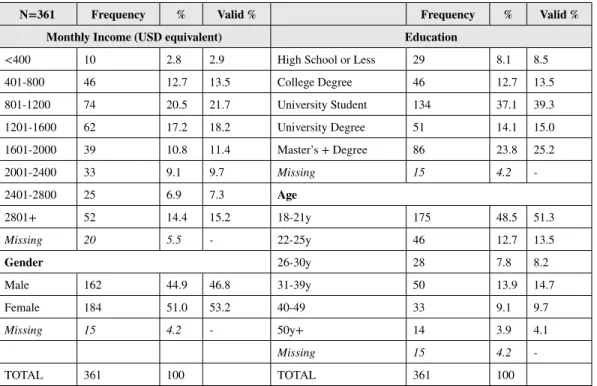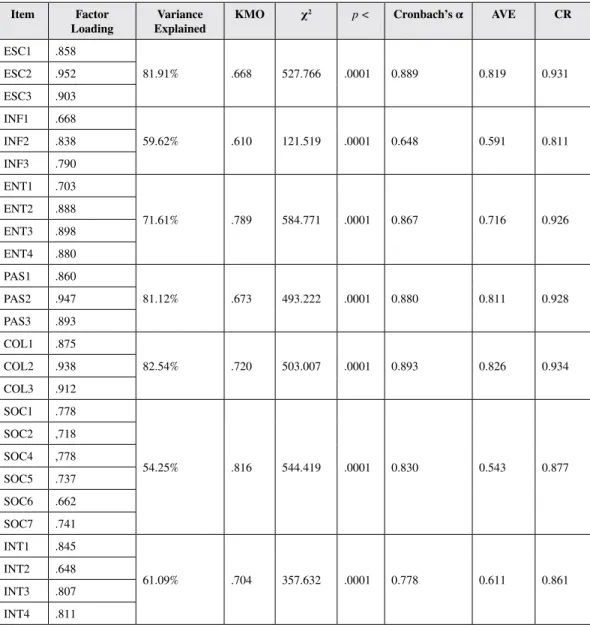DOI: 10.4018/IJEBR.2019040103
Copyright©2019,IGIGlobal.CopyingordistributinginprintorelectronicformswithoutwrittenpermissionofIGIGlobalisprohibited.
Examining Social Commerce Intentions
Through the Uses and Gratifications Theory
Gokhan Aydin, Istanbul Medipol University, Istanbul, Turkeyhttps://orcid.org/0000-0002-5652-8694 ABSTRACT Changesinconsumerbehaviorenabledbysocialnetworkingtechnologiesisleadingtoatransformation ine-commerce.Consumers’useofsocialmediasitesandrelevanttechnologiesfordifferentaspectsof shoppinghasbecomeanissueofutmostconcerntoretailersandrelatedbusinesses.Adoptingauses andgratificationstheory(UGT)perspective,thearticleaimstodemonstratemotivesofusersutilizing socialmediaintheirpurchasedecisions.Drawingfromdigitalmarketingande-commerceliterature, relevantusesandgratificationsforsocialcommerce(s-commerce)werechosenasinformationaccess, escape,entertainment,passingtime,coolandnewtrends,andsocialization.Theproposedmodelwas analyzedandtestedviaOLSregressionandANOVAanalysisusingthedatacollectedfromasurvey studyon361subjectsinTurkey.Informationaccess,relaxingentertainment,andsocializationmotives emergedassignificantantecedentsofs-commerceintentions.Nosignificanteffectofdemographics onsocialcommerceintentionswereobservedintheanalysis. KEywoRdS
E-Commerce, S-Commerce, Social Commerce, Social Media, Social Networks, UGT, Uses and Gratifications 1. INTRodUCTIoN Easeofaccesstoinformation,productsandservicesthroughInternetandinformationtechnologies, coupledwiththerapidadoptionofinteractivetechnologiesandsocialnetworksallovertheworldare transforminghowbusinessandcommerceisconducted.Asthenumberofusersofsocialmediasites suchasFacebook,TwitterandInstagramgrow,variousbusinessesstartedusingtheseplatformsasan influentialchanneltoreachandconnectwithpotentialandexistingcustomers.Socialnetworkingsites canbeleveragedtocreatetrustandpersuadeconsumerstochooseproducts,however,controloverthe contentpublishedontheseplatformsislimited.Toovercometheselimitationse-commercecompanies startedprovidingopportunitiestocomment,appraiseandsharecontentontheirownplatformsto createaninteractiveenvironmentforusersthatisaliketosocialmedia.ThistransitiontoWeb2.0, whichfacilitatesinteractionbetweenusersandorganizations,andprovidesparticipationandsharing opportunitiestoitsparticipantshasledtotheemergenceofsocialcommerce(s-commerce)concept in2005.Ithasbecomeahottopicsincethen(Curty&Zhang,2011)andinterestonitisexpectedto increaseasitgainsmoresignificance(Chen&Shen,2015;Lin,Li,&Wang,2017).Accordingtoa systematicreviewofscholarlyarticlespublishedbetween2000to2014,“socialmediamarketing”, “onlineshopping&e-commerce”areamongtheTop-10topicsofonlinemarketingresearch(Roy, Datta,&Basu,2017).Tworecentliteraturereviewsons-commercethatanalyzedmorethan100and 400studiesrespectively,stressedouttheincreasingsignificanceofthisconcept(Busalim&Hussin, 2016;Linetal.,2017).Thisphenomenonishighlightedbytheincreasingnumberofarticles-11in
2011to58in2016-appearinginWebofKnowledgedatabasefor“socialcommerce”or“s-commerce” termsinmanuscripttitles. Socialcommerce(s-commerce)isconsideredasanewformofelectroniccommerce(e-commerce) whichinvolvessocialnetworkingsystemsthatenablesocialinteractionandusercontributions(Liang, Ho,Li,&Turban,2011).Asignificantmajorityoftherelevantliteratureacceptssocialcommerceas theuseofsocialmediasitesinvariousstagesofconsumerdecisionprocessands-commerceactivities actasanenablerofonlinepurchaseprocess(Shen,2012). S-commerceisexpectedtobecomeoneofthemostwidelyadoptedelectroniccommerceplatforms inthenot-so-distantfuture(ZhangandBenyoucef2016).Socialnetworkingsitesandrelevanttools provideabundantopportunitiestobrowseproductsandtogetcommentsandreviewsprovidedbyreal usersandpeers.Consequently,severalcompanieshavemadeeffortstogetafirmfootholdandcarry outactualsalestransactionsoversocialmedia.Forinstance,Dellclaimedthatitmade$6.5million bysellingcomputersonTwitterbetween2007and2010andDisneyallowedpeopletopurchase ticketsdirectlyonFacebookwithoutleavingthesocialnetwork(Turban,Strauss,&Lai,2015,p.12). Facebook,notsolongago,launchedFacebookMarketplace,aplatformthatfacilitatesbuyingand sellingofgoods.Furthermore,FacebookownedInstagramexpandedits“shoppableposts”feature, whichprovidebrandstheabilitytoadde-commercelinkswithintheirInstagrampoststohelpdrive transactions,toninecountries(Instagram,2018). Companiespracticinge-commerce,especiallyretailers,wanttoleveragethebenefitsofsocial mediatoagreaterextent.Forinstance,InstagramandPinterest-themorevisuallyattractivesocial platforms-haveenticedtheinterestofbusinessesandentrepreneurs.Theseplatformsareutilizedfor promotionandmarketingcommunicationsaswellasdirectlysellingproductstousers(Instagram, 2018).ToexploittheopportunitiesofferedbyWeb2.0andsocialnetworkingsystems,itisimperativeto studyandunderstandconsumermotivationsintheseenvironments.Withinthisdynamicenvironment, thepresentstudyofferstwomajorcontributionstothes-commerceliterature.Fromatheoretical perspective,amodelbasedonawell-establishedtheoryonconsumermotivesinsocialmediause, namelyUGTisutilizedtoenhancetheclassicalutilitarian&hedonicmotivationperspectivethat isusedextensivelyinshoppingliterature.UGTisutilizedbyresearchersinseveralcontextsuchas mobileappusebehavior(Ha,Kim,Libaque-Saenz,Chang,&Park,2015),socialmediausebehavior (Gan&Li,2018;Phua,Jin,&Kim,2017),andonlineshoppingusebehavior(Lim&Ting,2012) inadditiontoitsoriginalsetting,massmediacommunications(Katz,Blumler,&Gurevitch,1974). Uptillthisstudy,UGT’sapplicationtosocialcommerceislimitedtoonlyafewstudies(Sharma &Crossler,2014;Yang&Li,2014).Thistheoreticalapproachprovidesanovelperspectiveatthe s-commerceusebehaviorcomparedtoextantliteratureasthegeneralhedonicmotivesconstructs utilizedinrelevantliteratureissomewhatlimitedcomparedtodetailedsub-categoriesprovidedby UGT.Fromamanagerialperspective,themajorcontributionisconfirming/refutingtransferability ofexistingknowledgeone-commercetos-commerce.Thisresearchiscarriedoutinadeveloping country,Turkey,situatedatthecrossroadsofAsiaandEuropewithconsumersinfluencedbyboth WesternandEasternculturalaspects.Giventhatpriorresearchons-commerceconsumermotives indevelopingcountriesisscarce,testingfortherelevanceofeachgratificationinnewsettingsis crucialtoarriveatvalidconclusions.Inaddition,theeffectofdemographicsthatarebecoming lessmeaningfulinexplainingdifferencesintechnologyadoptionconsumerbehaviorindeveloped countriesmaynotreflecttodevelopingmarketswell.ConsideringthedifferingpropertiesofTurkish cultureintermsofdemographics,especiallyingenderequalityandwomen’ssocialstatus,maylead toconflictingresultswiththecurrenttrendsindevelopedcountries. Inlinewiththeresearchgap,thefollowingresearchquestionsareaimedtobeansweredwith thepresentstudy: Q1:Howdifferenttypeofmotives/gratificationsaffectsocialcommerceintentions? Q2:Domajordemographics(age,gender,educationandincome)affectsocialcommerceintentions?
Q3:Domajordemographics(age,gender,educationandincome)affectusermotivations/gratifications onsocialcommerceintentions? Inordertoanswertheaforementionedresearchquestions,e-commerceands-commerceconsumer behaviorliteraturewereexamined.Theresearchmodelwasdevelopeduponshoppingvalues,UGT andrelevantmotivationalstudies.HypothesesweredevelopedandpresentedinSection2,where thetheoreticalbackgroundisponderedindetail.Thissectionisfollowedbymethodologywhere sampling,data-collectionandresearchmodelisdescribed.Inaddition,operationalizationofeach relevantconstructandthescalesutilizedarelikewisepresentedinSection3.Dataanalysisandresults areprovidedinSection4.ThefindingsarediscussedinSection5wheretheoreticalandpractical contributionsofthepresentresearchareprovided.Thepaperisconcludedbyhighlightingthestudy’s limitationsandprovidingfutureresearchavenues. 2. THEoRETICAL BACKGRoUNd
2.1. Social Networking Sites & Social Media
Socialnetworksites,socialmediaandWeb2.0hasbeenusedinterchangeablyintheliterature. DerivedfromthecategorizationbyConstantinidesandFountain(2008),basiccategoriesofsocial mediacanbelistedasfollows:blogsµblogs(i.e.Wordpress,Blogger,Twitter),general socialnetworkingsites(i.e.Facebook),thematicandprofessionalnetworkingsites(i.e.Linked-in), contentsharingsites&communities(i.e.Flickr,Youtube,5oopx),forums/bulletinboards,content aggregators,socialbookmarkingsites&collaborativefilteringsites(i.e.Stumbleuponordel.icio. us).Asthiscategorizationhighlights,socialnetworkingsitesarenotlimitedtosocialmediasites suchasFacebookbutencompassawiderrangeofsitessuchasforums,blogs,onlinecommunities andwikis.Consequently,useofsocialmediaine-commerce/onlineshoppingcanbepracticedin awide-varietyofplatforms.
2.2. Consumer Motives in Shopping and E-Commerce
Consumermotivesindicatetheprocessesoriginatedbyneedsarousedinanindividualtoachieve certainbenefitsoravoidunsoughtoutcomes(Solomon,2009).Humanmotiveshavebeencategorized intwobasiccategories,namelyutilitarianandhedonicinconsumerbehaviorliterature(Hirschman &Holbrook,1982).Thus,basicallyconsumersshoponlineorofflinewithtask-focusedutilitarian motivesorhedonicexperientialmotives(Büttner,Florack,&Göritz,2013).Thesefundamentalmotives maybesegmentedintomoredetailedneedsaswell.UsingvariousaspectsofWeb2.0technologies, e-commerceisbecomingamediumthatcanprovidehedonicexperiencesforconsumers(Fang, George,Shao,&Wen,2016).Theextantliteraturethatfocusesonmotivationshaveconsideredseveral typesofgratificationsunderalargerhedonicmotivationscontext.Hedonicorexperientialaspects ofshoppingincludeadventureseeking,pursuingnewexperiences,sensorystimulation,andescape fromdailylifeandboredom.Essentially,thesesub-dimensionsofhedonicvalueareconsideredina multi-facetedwayintheUsesandGratificationsTheoryleadingustoadoptittoinvestigatesocial commerceconsumerbehaviorinadetailedway.
2.3. S-Commerce and E-Commerce
Thedifferingapproachestodefineandoperationalizesocialcommerceisevidentintheextant literature.Inonehand,therearetransactionalapproachesthatdefinesocialcommerceas“useof socialmediafortransactionsandactivitiesthataredrivenprimarilybysocialinteractionsanduser contributions”(Zhangetal.2014;Liangetal.2011).Asimilarperspectivetiesthedefinitionof s-commercetoe-commerceandacceptsitasasub-categoryofe-commerce(Turban,Bolloju,& Liang,2010).Consideringthate-commerceitselfisdefinedinvariousways(transactional-exchange
ofgoods,servicesorawiderrangeofbusinessactivitiesincludinginformationexchangesuchas marketing,customercomplaintmanagement,supplierrelationsetc.),thisperspectiveprovidesa broaderrangeofoperationalizationthatisnotlimitedtotransactions(Chaffey,2009,p.10;Turbanet al.,2015).Fromadifferentpointofview,s-commercehasbeendefinedas“aformofInternet-based ‘socialmedia’thatallowpeopletoparticipateinthemarketingandsellingofproductsandservices inonlinemarketplacesandcommunities”(Stephen&Toubia,2010;Turbanetal.,2015,p.12).This approachhighlightssocialmedia’sroleandtheintegrationofsocialnetworkfeaturesintointernet retailers’systems.Thus,s-commercecanbeconsideredasanevolutionofWeb2.0technologies toonlinecommerceoperationsaswell(Busalim&Hussin,2016;Turban&Liang,2011).Web 2.0technologiesprovideincreasedinteractivityandleadtohigherparticipationofconsumersin variousstagesofe-commercebymeansofwritingandsharingblogs,commentingorratingsystems andsimilartools.Giventhewiderangeofsocialnetworkingsystemsavailabletoconsumersthat facilitatetwo-waycommunication,socialcommerceisnotlimitedtogeneralsocialmediasitessuch asFacebook.Otherplatformsandtoolsincludingforums,ratings,reviewssites,recommendations one-commerceplatforms,blogsandothersenablesocialcommerce(Kucukcay&Benyoucef,2014). Themajorityoflargee-commercesitessuchasAmazon.comincorporatesocialnetworkingtools (i.e.ratings,commentsystemsetc.)totheirsystemstoenablesocialinteractionwithinthesystem. Moreover,theyarealsoofferingnewapplicationssuchasSparkbyAmazonthataimusersofsites suchasPinterestorInstagramthatarebecomingvenuesforshopping(Natanson,2017).
2.3.1. Social Commerce Intentions
Asdiscussedpreviously,s-commerceisdefinedindifferingwaysintheextantliterature.Itisusually consideredasatypeofelectroniccommerceactivity(Turban&Liang,2011).However,considering theproliferatedtypesofsocialnetworkingsitesandthevarietyoftoolseachutilizeitishardtoarrive atagloballyaccepteddefinition.Withinthecontextofthisstudys-commerceconceptisbasically operationalizedas“theuseofsocialmediainbuyingprocessofconsumers”.Intentiontousesocial commerceistermedass-commerceintentionsforconveniencethroughoutthisstudy.S-commerce intentionsarerevealedviaquestioningtheusers’tendencytofollow/giveonlinerecommendations onsocialmediaandtheirintentionstousesocialmediaintheirshoppingdecisions.Despitethe risinginterestinthisconcept,theunderlyingmotivationsthataffects-commercearenotclearas thereareseveralrelevantstudieswithcontradictoryconclusions.Thedifferencesinmotivating factorsaswellasvariablessuchasdemographicsareevidentintheliterature.Anoverviewofthe literatureondemographics’effectsone-commerceandrelevanttechnologyadoptionisprovidedin thefollowingsection.
2.4. Uses and Gratifications
Toexploreconsumermotivationsinonlineshoppingands-commerceinmoredetail,Usesand GratificationsTheory(UGT)isadoptedinthepresentstudy.Theclassicalutilitarianandhedonic value/motiveframeworkisembracedfromawiderperspectiveinUGT,aconsumer-centricapproach thatwasoriginallyusedtoexplainconsumermotivationsandeffectivenessofmass-mediause. AccordingtoUGT,“gratifications”aretheperceivedfulfillmentofaneedthroughanactivity,for instanceaparticularmediause.Consequently,UGTtriestoexplainandunderstandthepsychological needsthataremotivatingindividualstousecertainmediaandtheresultinggratificationsthatfulfill theseneeds(Katzetal.,1974).InUGT,cognitiveneeds,affectiveneeds,relaxationneeds,personal andsocialintegrativeneedsareconsideredasfundamental‘needs’categories.Similarly,toanswer thesebasicneeds,cognitivebenefits,social-integrativebenefits,personal-integrativebenefits,and hedonicbenefitsareconsideredintheliterature. Cognitivegratificationsorbenefits,involvemedia’sabilitytodeliverdesirableinformation, whereas social integrative benefits indicate media’s ability to enable social interaction and strengtheningtheconsumer’stieswithothers.Personalintegrativebenefitsareassociatedtothemedia’s
abilitytoenhanceusers’credibility,status,reputationandconfidence.Finally,hedonicbenefitsrefer totheaestheticandpleasurableexperiencesobtainedfromusingmedia(Katz,Blumler,&Gurevitch, 1973;Nambisan&Baron,2007;Verhagen,Swen,Feldberg,&Merikivi,2015). Albeitoriginatingfrommasscommunicationusebehavior,UGTisawell-establishedapproach thathasbeenutilizedtoexamineconsumerbehaviorinseveralcontexts.Initsearlyapplications maingratificationsidentifiedformediausewererelatedtoentertainmentandinformation.Recent studiesusingUGTonnewcommunicationmediasuchassocialmediaandmobiledevicesalso haveidentifiedsimilarmotives.Internet/websiteuse(Eighmey&McCord,1998),mobileappuse behavior(Haetal.,2015),socialmediausebehavior(Gan&Li,2018;Joinson,2008;Phuaetal., 2017),andonlineshoppingbehavior(Joines,Scherer,&Scheufele,2003;Lim&Ting,2012)are amongrelevantcontemporaryapplicationareasthatobtainedsimilarconclusions.Intriguingly,UGT canbeconsideredamoresuitabletheorytoapplytosocialmediathantraditionalmediainourcurrent environment.UGTassumesactiveparticipationofusersandanintentionalpurposeinconsuming/ usingmedia.Unlikeunwillingexposuretotraditionalmedia(outdoor,radioetc.)socialmediausers willinglypreferandusethesemedia(Haetal.,2015;Xu,Ryan,Prybutok,&Wen,2012). StudiesbasedonUGTidentifiedseveralgratificationsthatanindividualachievesfromusing socialmedia,resultedingratificationsrelevantins-commercecontext(Yang&Li,2014).For instance,PapacharissiandMendelson(2011)’sstudyonFacebookusebehaviorledtonineseparate motives:informationsharing,habitualpasstime,relaxingentertainment,escapism,coolandnew trend,companionship,professionaladvancement,socialinteractionandmeetingnewpeople.Other researchershaveledtosimilarusesandgratificationsofsocialmediasuchasaffection,coordination, disclosure,entertainment,escape,immediateaccess,relaxation,stylishness,leisure,socialpresence, followingfashion,demonstratingsociability,andimprovingsocialknowledge(Papacharissi& Mendelson,2011;Phuaetal.,2017;Smock,Ellison,Lampe,&Wohn,2011;Whiting&Williams, 2013;Xuetal.,2012). Amongthemanygratificationsputforwardintheextantsocialmediaands-commerceliterature, thefollowingwereselectedastheycoverbasicneedsandofferthebalancebetweenparsimonyand enoughdepthtouncoverrelevantmotives: • Cognitive Needs:informationseeking • Affective/Hedonic Needs:escape,entertainment,passingtime • Social Needs:Socializationgratification,Cool/newtrend 2.4.1. Information Informationrelatedgratificationsarethemajorcognitivegratificationofusingmediaaccordingto UGT.Fromashopping-valueperspective,thisisthemajorcomponentthatreflectstheutilitarian motives.Informationrelatedmotivesareoperationalizedinseveralwaysintheliteraturefocusingon UGTsuchasinformationseeking,informationaccessandinformationquality.Thisgratificationis relatedtosatisfyingtheusers’apparentorlatentinformationneeds.Dependingonthecontext,theusers mayseektheinformationhimself/herself,itmaybeprovidedbymassmediaorprovidedonwebpages /shoppingsites.Inanonlinecontext,thesearchforinformationisoneofthemajorreasonsInternet andwebsitesareusedfor(Papacharissi&Rubin,2000;Peffers,2001).InrelevantstudiesonInternet useande-commerce,seekingforandacquiringinformationwasfoundtoinfluencesatisfactionof users(L.Chen,Gillenson,&Sherrell,2002;Joinesetal.,2003;Song,Larose,Eastin,&Lin,2004). Likewise,obtaininginformationusingsocialmediasitesisacognitivegratificationthatwasfoundto beamongthemainreasonstousesocialmedia(Hicksetal.,2012;Park,Kee,&Valenzuela,2009). Acquiringinformationsharedandunderstandingwhatotherpeople-especiallyofsignificance-think ofisavaluespecifictovirtualcommunitiessuchassocialmediasites.Asimilarconceptdefiningthe behaviorofconsumerstobrowseproductsforcollectinginformationonnewfashiontrendsiscalled
ideashopping(Bloch,Ridgway,&Sherrell,1989).Seekinginformationonfashiontrendsinitselfis consideredasastand-alonegratificationtobrowseproducts(Arnold&Reynolds,2003).Information seekinggratificationthatisoperationalizedinthisstudyisdefinedas“acquiringinformationtohelp incommerceactivitiesandbuyingdecisionsonsocialnetworkingsites”(Yang&Li,2014).Inthe extantliteratureonsocialmediause,informationrelatedgratificationswerefoundtohaveapositive effectonrelevantdependentvariablessuchasuseintentions(Bonds-Raacke&Raacke,2010;Haet al.,2015;Parketal.,2009).Inaddition,itwasfoundtobeasignificantmotivationforusingvirtual communitiesandsocialcommercesites(Teo,Chan,Wei,&Zhang,2003;Yang&Li,2014)and engagingine-commerce(Liu&Forsythe,2010). Inaccordancewiththeestablishedstudies,informationseekinggratificationishypothesizedto haveapositiveeffectons-commerceintentions. H1:Informationseekinggratificationwillhavepositiveeffectons-commerceintentions. 2.4.2. Entertainment AccordingtoUGT,entertainmentisoneofthemajorfactorsthatmotivateuserstouseaparticular media(Eighmey&McCord,1998;Luo,2002)suchassocialmedia(Xuetal.,2012).Entertainment isarelevantmotiveinretailandshoppingliterature,generallyconsideredashedonicorexperiential motives.Hedonicmotiveshasbecomeassignificantasutilitarianmotivesinpurchasedecisions, moreover,shoppinginitselfisameanstocreatejoyandtoentertainoneself(Babin,Darden,& Griffin,1994;Childers,Carr,&Carson,2001).Inonlineshopping,consumersenjoytheshopping processitselfandshoppingbehavioringeneralisperceivedasafunactivityasopposedtobeing atedioustaskorjobtobefinished(To,Liao,&Lin,2007).Onlineshopperspursueentertainment byusingnewtechnologiesduringonlineshopping(Kim&Forsythe,2007).Researchfocusingon socialnetworkingsiteandgeneralinternetuseindicatedthatentertainingwebsitesprovidehigher satisfaction(Luo,2002)andtheentertainmentgratificationisamongthemostsignificantfactors affectingattitudestowardswebsites(Hausman&Siekpe,2009).Besides,itwasalsoshownthat entertainmentaffectsusers’participationbehavior(Choietal.,2016;Dholakia,Bagozzi,&Pearo, 2004).Similarly,instudiesone-commerce,entertainmentfactorwasfoundtohaveapositiveeffect oncommercial-orientedmediausage(Hicksetal.,2012;Lim&Ting,2012)andacceptedasa significantpredictorofbehavior(Childersetal.,2001). Basedonextantliterature,entertainmentinsocialcommercecontextcanbedefinedas“theextent towhichtheusersperceiveusingsocialmediaforcommerceasrelaxing,funandentertaining”(Hicks etal.,2012;Lim&Ting,2012).Itwasfoundtobeamajormotivationforusingsocialcommerce sites(Yang&Li,2014),therefore,wehypothesizeentertainmentgratificationtohaveapositive effectons-commerceintentions. H2:Entertainmentgratificationwillhavepositiveeffectons-commerceintentions. 2.4.3. Passing Time Internetandsocialmediacanbeusedinvariousways.Socialmedia,withitsinfinitescrolling,offers aneffectivewaytoutilizeone’sfreetime.Thepassingtimegratificationisgroundedonthispremise andcanbedefinedsimplyasusingsocialmediatopassidletime.Inseveralstudiesonsocialmedia, passingtimegratificationwasfoundtobepositivelyrelatedtosocialmediausebehavior(Hicksetal., 2012;Sheldon,2008).Consumerscanseewhattheirfriendsareusing,buying,searchingforandthey canreadandwriterelevantcomments.Consequently,passingtimegratificationcanbeassumedto haveapositiveeffectons-commerceintention.Thestudiestestingforthishypothesizedeffectfound weakorinsignificanteffects.Forinstancepassingtimewasfoundtobeaninsignificantpredictor ofsocialcommerceinYangandLi(2014)’sstudybutfoundtohaveasignificanteffectincertain
othersonsocialmedia(Hicksetal.,2012;Sheldon,2008).Furtherstudiesindifferentcontextsare neededtoarriveatmeaningfulinsights,thuswehypothesizepasstimegratificationtohaveapositive effectons-commerceintentions. H3:PassingTimegratificationwillhavepositiveeffectons-commerceintentions. 2.4.4. Escape EscapegratificationisamongthehedonicaspectsofUGTandisconsideredtosatisfytension-free needs.Escapecanbedefinedasparticipatinginactivitiestogetawayfromtherealworld,theproblems andpressuresofdailylife(Xuetal.,2012).Consideringthatsocialmediaasavenuethatpromote easycommunication,sharingandentertainment,itisanalternativetoeasilyescapeproblemsand pressuresofdailylife.However,studiesincorporatingescapegratificationhaveledtocontradicting results.Escapegratificationwasfoundtopositivelyaffectintentionsandbehaviorinseveralstudies onshoppingandsocialmedia(Korgaonkar&Wolin,1999;Papacharissi&Mendelson,2011;Smock etal.,2011)whereasthiseffectwasfoundtobeinsignificantinothers(Xuetal.,2012;Yang& Li,2014).Itshouldbenotedthatescapismhavebeenconsideredunderalarger“entertainment”or “hedonicmotivation”constructincertainmotivationalstudiesonshopping(Hirschman&Holbrook, 1982)andsocialmediause(i.e.Haetal.,2015;Smocketal.,2011).Thelimitednumberofstudies thathaveincorporatedthisgratificationseparatelylimitstheabilitytojustifythediscrepancies. Therefore,tooffernewevidenceandtestforthesignificanceofthisfactor,escapegratificationwas hypothesizedtohaveapositiveeffectons-commerceintentions. H4:Escapegratificationwillhavepositiveeffectons-commerceintentions.
2.4.5. Cool & New Trend
TherelevantliteratureonUGTinsocialmediareveal“coolandnewtrend”gratificationasapossible factoraffectinguserbehavior.Thisgratificationrestsuponthebeliefthatindividualsusenewmedia andtechnologiesbecauseitisthethingtodoandeverybodyelseisdoingit.Thisgratification pointstothesymbolicbenefitsofusingmediaandtechnologiesasawaytoachieveandsustain socialacceptance.Forinstance,twostudies,onebySheldon(2008)andtheotherbyPapacharissi andMendelson(2011)onmotivesforusingFacebookfoundcoolnessandnewtrendamongother factorstobeasignificantmotive.Coolandnewtrendgratificationinsocialcommercecontextrefer tousersutilizingsocialcommercetolookcoolandfashionable.Giventhatusersperceivesocial commerceasareasonablynewtrend,itispossibletofeelcoolbenefitingfroms-commerce(Sharma &Crossler,2014).Therefore,wehypothesizecoolandnewtrendgratificationtohaveapositive effectons-commerceintentions. H5:Coolandnewtrendgratificationwillhavepositiveeffectons-commerceintentions. 2.4.6. Socialization Anothermatterofdebateisthesignificanceofthe“social”aspectofs-commerce.Bothsocialmedia andshoppinghave“social”aspects.Apartfromutilitarianbenefitsorpureenjoymentpurposes, shoppingcanbeusedasawaytosocializeaswell.Thisphenomenonofshoppers’desireforsocial interactionwithothersofsimilarinterests,andaffiliatingwithreferencegroupswasproposedby Tauber(1972)andReynoldsandBeatty(1999)highlightedsocialneedsinshoppingenvironments. Theseneedsareconceptualizedassocialshoppinginaseparatestudy(Arnold&Reynolds,2003). Considerationofsocialmotivesine-commercesettingappearedintheformofalackofsocialization
inearlye-commerceoperationsthatcandeterconsumerstoshoponline(Swaminathan,Lepkowska-White,&Rao,1999).However,withtheemergenceofmobiletechnologiesandWeb2.0technologies, onlineshoppinghasinheritedasocialaspectaswell.Accordingly,socialshoppingbegantoactasa significantfactorinfluencinguserbehavioronm-commerceands-commercecontexts(Åkesson,2007; Parker&Wang,2016).Socialmedia-initself-derivesvaluefromthecommunicationandinteractionit providestousers.Consequently,socialinteractionisanaturalelementofsocialmediasites.Meeting theexpectations,thestudiesonsocialmediaresultedinthenotionthatpeopleusesocialnetworksites forsocializinginadditiontootherneedssuchasself-statusseekingorentertainmentgratifications (Parketal.,2009;Whiting&Williams,2013).Ithasbeenshownthatsocialinteractionsoninternet, whethertheybeonsocialmediaorwebsites,leadtohigherengagement.Forinstance,itwasfound thatsocialinteractionmotivationpositivelyaffectsthetimespentonawebsite(Ko,Cho,&Roberts, 2005).UsingWeb2.0technologiesandsocialnetworkingsites,consumersareabletoconnectwith othersofsimilarinterests.Thesetiescreatedovervirtualenvironmentsarepositedtobeinfluential inconsumerbehaviorandpurchasingdecisions(Choietal.,2016).Studiesconsidering“social” dimensionofsocialnetworkingsitesinshoppingcontextssuchas“socialcapitaltheory”(Nahapiet &Ghoshal,1998)and“socialidentification”(Farivar,Turel,&Yuan,2018)socialinteraction(J. Huang&Zhou,2018)haveledtoconclusionsthatsocialinteractionsaffectpurchaseintentions(i.e. L.T.Huang,2016). Inthelightofthestudiesonsocialmedia,e-commerce,andshoppingvalue,wehypothesize socializationtohaveapositiveeffectons-commerceintentions. H6:Socializationgratificationwillhavepositiveeffectons-commerceintentions. 2.5. Effect of demographics on Gratifications & S-commerce
Theexistingliteratureexaminingtheeffectsofdemographicsontechnologyandinformationsystems usesuggeststhatdifferencesexistwithregardstoage,genderandincome(Morris&Venkatesh, 2000).However,effectofdemographicsonuseintentionswerenotcoveredinestablishedconsumer behaviortheoriesandthelackofawell-foundedframeworkpresentsaresearchgap.Asummaryof relevantstudiesoneffectofdemographicsisprovidedinthissectiontoofferinsightsonpotential effectsinsocialcommercesetting. TheyoungerpopulationhavebeenexposedtoInternetandsocialmediaatearlieragesandadigital dividebetweengenerationsisevidentinestablishedstudiesontechnologyadoption(Korgaonkar& Wolin,1999;Pfeil,Arjan,&Zaphiris,2009;ViswanathVenkatesh&Morris,2000).Ithasbeenfound thatolderusershavelowerperceivedtechnologicalskills(Chung,Park,Wang,Fulk,&McLaughlin, 2010)andlackofITexperiencecoupledwithresistancetochangecreatesbarriersofadoptingnew technologyandproducts(Trocchia&Janda,2000).Severalstudieshaveconsideredageasasignificant factorthataffectsonlineshopping/e-commercebehavior(Bigné,Ruiz,&Sanz,2007;Hernández, Jiménez,&JoséMartín,2011;Liébana-Cabanillas&Alonso-Dos-Santos,2017;Stafford,Turan,& Raisinghani,2004).Itshouldbenotedthatnotallresearchyieldeddifferencesamongagegroups inshopping.Insignificantrelationshipsincommercerelatedtechnologyuse(Dabholkar,Michelle Bobbitt,&Lee,2003;Hernándezetal.,2011)orevennegativerelationshipsthanexpected(Joines etal.,2003)werealsodetectedinshoppingliterature.Thiscreatesaresearchgapthatfurtherstudies indifferingcontextsmayshedlighton. Anothersignificantdemographicthatisconsideredtohaveaneffectontechnologyadoptionand e-commerceusebehaviorisgender(Morris&Venkatesh,2000;Sun&Zhang,2006).Ithasbeen shownthatbehavioralintentionsofmenwereaffectedtoagreaterextentbytheusefulnessofthe technologythanwomen(Venkatesh,Morris,andAckerman2000).Women,ontheotherhand,aremore susceptibletoexternalinfluence(i.e.socialinfluence)thanmen(Haferkamp,Eimler,Papadakis,& Kruck,2012;Muscanell&Guadagno,2012;Sun&Zhang,2006).Thegratificationsofsocialmedia userswasfoundtovarywithdependingongenderaswell(Parketal.,2009).Effectofgenderon
onlinedecisionmakingandshoppingbehaviorhasalsobeenanareathathaveattractedresearchers’ interest(Hernándezetal.,2011;Lin,Featherman,Brooks,&Hajli,2018;Sun&Zhang,2006). AccordingtoSheldon(2008),womenaremorelikelyusesocialmediaforentertainmentpurposesand maintainingexistingrelationships,whereas,menareafterdevelopingnewrelationships.Interestingly newmethodologiespavewaytopredictgenderbasedonthedataobtainedfrome-commercewebsites (Duong,Tan,&Pham,2016).Despitethesefindings,contradictoryconclusionsarepresentongender’s effectontechnologyuse,mediaconsumptionande-commerce.Forinstance,Nysveen,Pedersen, &Thorbjørnsen,(2005)’sstudyonpersonalmotivesformediaconsumptionand(Faqih&Jaradat, 2015)’sstudyonmobilecommerceindicatednodifferencesbetweengenders.Thehighlycitedwork ofVenkateshetal.(2000)demonstratedthatmediumtolong-termdecisionswerenotmoderatedby genderofusers.Ithasbeenshownthatiftherespondentsarefamiliarwiththetechnology/service inquestiontherearenosignificantdifferencesbetweengenders(Wong&Hanafi,2007).Onthe otherhand,accordingtotheTurkishStatisticalInstitutestatistics,thereisagenderimbalanceamong internetshoppersinTurkey.Thepercentageofmalesshoppingonline(34%)arehigherthanthatof females(25%)(TurkishStatisticalInstitute,2018).Thesephenomenaindicatearesearchgapaimed tobeexploredbythisstudy. Inadditiontoageandgender,incomecanbeconsideredanimportantdemographicine-commerce ands-commercesettingsasitaffectstheabilityoftheconsumerstopurchase.Consumerswithhigher incomearefacedwithlessperceivedfinancialriskwhenshoppingonlinecomparedtoconsumerswith lowerincome.Consumerswithlowerincomemaynoteasilyaccesse-commerce(includingmobile orsocialcommerce)ormaynotbeasexperiencedashigher-incomedcounterparts.Consequently, itmaybeconsideredasanenableroforbarriertoe-commerce(Hernándezetal.,2011).Ithasbeen consideredasasignificantfactorinrelevanttechnologyadoptionsuchasmobilepaymentsystems (Shin,2009)andmobilecommerce(Zhang,Zhu,andLiu2012).Researchersconsideredincomeasa factorthataffectsshoppingbehavior(Miyazaki&Fernandez,2001;Valarezo,Pérez-Amaral,Garín-Muñoz,HergueraGarcía,&López,2018),yetnotallfindingsareconsistent.Incomehasbeenfound asasignificantfactoraffectinge-commerceusebehavior(Valarezoetal.,2018)anditssignificancein emergingmarketshasbeenemphasized(Zhangetal.,2012).Ontheotherhand,Bignéetal.(2007), Gibreel,AlOtaibi,andAltmann(2018)foundnosignificanteffectofincomeonmobileandsocial commerceintentionsintheirstudiesrespectively. Basedonthefindingsintechnologyadoptionande-commerceliterature,gender,age,education andincomeareacceptedasmajordemographicsthathaspotentialeffectsons-commerceintentions andgratifications,thusthefollowingarehypothesized: H7:Maleswillhavehighersocialcommerceintentions. H8:Youngeragedrespondentswillhavehighers-commerceintentions. H9:Highereducationwillleadtohighers-commerceintentions. H10:Higherincomewillleadtohighers-commerceintentions. H11:Femaleswillhavehigherhedonicmotives(entertainment,passingtime,escape).whereasmales willhavehighercognitive(information)andsocialmotives(socialization). H12:Youngeragedrespondentswillhavehigherhedonicmotives(entertainment,passingtime, escape)andsocialmotives. H13:Highereducatedrespondentswillhavehighercognitivemotives(information)whereaslower educatedpeoplehavehigherhedonicmotives.
2.6. Context: Social Media Use in Turkey
Thereareover48millionFacebookaccountsinTurkey,wheremorethan80millionpeoplelives inalandontheintersectionofAsiaandEurope.Thisfigurecorrespondstonearlyallthecountry’s connectedpopulation,howeverduetomultipleaccounts,thenumberofuniqueusersisestimatedas
34million(Statista,2017;WeAreSocial&Hootsuite,2017).Facebookisthesecondmostpopular siteamonginternetusersinTurkeyaftergoogle.cominpageviews(IABTurkey,2017)andisthe mostpopularsocialmediasitefollowedbyInstagramandTwitter.Thecountry,withitsrelatively youngpopulationisamongtheexcessiveusersoftheInternetandsocialmedia.Turkeyisthe16th countryintermsoftimespentonlineand2.8hoursofeachdayisdevotedtosocialmedia(WeAre Social&Hootsuite,2017). 3. METHodoLoGy Themethodologyincarryingoutthepresentstudyisdetailedinthissectionstartingwiththeresearch modelvisualizedinFigure1,developedupontheoreticalfoundations.Themodelisfollowedbythe samplingapproachandmeasuresemployedinthestudy. 3.1. Proposed Model PresentedinFigure1. 3.2. Measures Eachconstructisdesignedbyadaptingexistingscalesofrelevantstudies.Thegratificationsare adaptedfrom(Smocketal.,2011);socializationmotivationfrom(Arnold&Reynolds,2003;Tauber, 1972)andsocialcommerceintentionsfrom(Zhangetal.2014;Liangetal.2011).Thedraftversion ofthequestionnairewasreviewedbythreemarketingacademicianstoensureeaseofunderstanding andcontextualrelevanceinTurkishlanguage.Moreover,apilottestwith28studentswasconducted tofine-tunethequestionnaire.
3.3. Sampling & Survey Administration
Thetargetpopulationisthesocialnetworkingsiteuserswhobenefitfromsocialmediaandsocial networkingtechnologiesintheirpurchasingdecisions.Thispopulationisdefinedasthesocial commerceusersinamorecompactform.Inordertotesttheaforementionedhypotheses,asurvey studywasconductedinTurkey.Conveniencesamplingandsnow-ballsamplingareusedtoreach potentialrespondents.Thesurveywasseededthroughtheresearcher’s,hiscolleagues’,acquaintances’,
students’andex-students’socialmediaaccounts(Facebook,LinkedInandTwitter)andpromotedin severalonlinegroups.Respondentsofthequestionnairewereaskedtoforwardthequestionnairetoa familymemberorfriendwhotheybelievemaybeinterestedins-commerceactivities.Participationin thesurveywasvoluntaryandthesurveywaskeptonlinefortwomonthsduringMayandJune2017. Usingtwofilterquestions,onetovalidatesocialmediauseandtheothertovalidatesocialmedia andrelevanttechnologiesuseforshoppingpurposes,atotalof361questionnaireswerecollected. TheinformationonthetotalsampleisprovidedinTable1and2. TheinformationprovidedinTable1andTable2revealthat91%oftherespondentsusesocial mediaactively.Itshouldbenotedthatthenatureofthesurveywasindicatedbeforehandtothepotential respondents,sotheywereawarethatstudywason“socialmedia”.Amongactiveusersofsocialmedia, 42%specifiedthattheyusesocialmediasitesforperiodslongerthan3hourseachday.Moreover, 76%ofactiveusersindicatedthattheyusesocialmediaintheirpurchasesinseveralways(looking fororreadingproductinfoorcomments,doingactualtransactions,etc.)47%ofthevalidrespondents weremaleand25%ofthemheldamaster’sorhigherdegree.Thesamplecanbeconsideredyoung, withalmosthalfoftherespondentsagedwithin18-21bracket.Giventheoverallsocialcommerce userdetailsareunknownitishardtogetarepresentativesample.However,consideringtheprofile ofInternetusersinTurkey,andFacebook&Instagramuserstatistics,theobtainedsamplereflects theoverallusersintermsofgenderandagebutskewedtowardshigherearners(TurkishStatistical Institute,2018).Socialmediausedurationperdayreflectsthepublishedsocialmediausestatistics inTurkey(WeAreSocial&Hootsuite,2017).
4. dATA ANALySIS ANd RESULTS
Outofthetotalsample,268usablequestionnaireswithfulldemographicsinformationwereobtained afteraccountingforfilteringquestions,non-completeandlow-qualityquestionnaires.Firstofall,
Table 1. Sample demographics
N=361 Frequency % Valid % Frequency % Valid %
Monthly Income (USD equivalent) Education
<400 10 2.8 2.9 HighSchoolorLess 29 8.1 8.5 401-800 46 12.7 13.5 CollegeDegree 46 12.7 13.5 801-1200 74 20.5 21.7 UniversityStudent 134 37.1 39.3 1201-1600 62 17.2 18.2 UniversityDegree 51 14.1 15.0 1601-2000 39 10.8 11.4 Master’s+Degree 86 23.8 25.2 2001-2400 33 9.1 9.7 Missing 15 4.2 -2401-2800 25 6.9 7.3 Age 2801+ 52 14.4 15.2 18-21y 175 48.5 51.3 Missing 20 5.5 - 22-25y 46 12.7 13.5 Gender 26-30y 28 7.8 8.2 Male 162 44.9 46.8 31-39y 50 13.9 14.7 Female 184 51.0 53.2 40-49 33 9.1 9.7 Missing 15 4.2 - 50y+ 14 3.9 4.1 Missing 15 4.2 -TOTAL 361 100 TOTAL 361 100
thecollecteddatawassortedandanalyzedinSPSS22.0software.Descriptivestatistics(means,std. deviationsandmedians)arecalculatedandprovidedinTable3. Amongthevariablestestedasthepredecessorsofsocialcommerceintention,thelowestscores wereattainedforthecoolandnewtrendgratificationandtheescapismgratification(avg.meansof 1.79and2.31ona5-pointscale).Thesignificantmajority(94%and91%)oftherespondentsanswered therelevantquestionsinanegativeorneutralway.Respondentsanswerstoescapismgratificationis similartopassingtimegratificationwithanaveragemeanscoreof2.31and21%answeringpositively totheitemsinquestion.Ontheotherhand,thehighestscoresareobtainedininformationseekingand entertainmentfactors(avg.meansof3.55and3.04ona5-pointscale.Informationseekingaspectof socialcommerceisperceivedinapositivewaybythe65%oftherespondents(4&5in5-pointscale) followedbyentertainment(41%answeredpositively).However,therespondents’dispositiontowards thesocialaspectofshoppingoperationalizedundersocialshoppingfactorisnotpositive.About28% oftherespondentsansweredtheitemsrelevanttothisfactorpositively(4&5ona5-pointLikertscale) andtheaveragescorewas2.67(outof5).Finally,thedescriptivestatisticsonthedependentfactor revealthatsocialcommerceintentionsareneutralwithdifferingviewsthroughoutthesample(avg. meanscore:3.12;st.dev.1.04).Thesefindingsareelaboratedtogetherwiththeregressionanalysis findingsinthediscussionssection.
4.1. Factor Analysis, Reliability & Validity
Asasecondstepoftheanalysis,aconfirmatoryfactoranalysiswascarriedoutandtheresultingfactor scoresareusedinaOLSregressionanalysis.Giventhateachquestiongroupisanestablishedscale thathasbeenpreviouslyvalidatedinnumerousstudies,contentandconstructvaliditywasconsidered tobesupported.Oneitemfromsocializationscale(SOC3)wasleftoutoffurtheranalysisdueto lowfactorloading.Compositereliability(CR)andCronbach’salphavalueswereusedtoassessthe internalconsistencyreliabilityofthemodel.ThefigurespresentedinTable4,areallabove0.7let
Table 2. Sample SNS use info
Using Social Media Frequency Percent Valid % Cumulative %
Yes 329 91.1 91.1 91.1
No 32 8.9 8.9 100.0
Using Social Media for Shopping
Yes 269 74.5 81.8 81.8
No 60 16.6 18.2 100.0
Missing(NoSNSUse) 32 8.9 -
-Social Media Use Per Day
<1hour 41 11.4 12.5 12.5 1-2hour 84 23.3 25.5 38.0 2-3hour 66 18.3 20.1 58.1 3-4hour 59 16.3 17.9 76.0 4-5hour 29 8.0 8.8 84.8 5-6hour 23 6.4 7.0 91.8 6+hours 27 7.5 8.2 100.0 Missing 32 8.9 - -Total 361 100.0 100.0 100.0
aloneinformationseekingfactor(α=0.65).Thefindingsindicatethescaleshaveacceptablereliability (Carmines&Zeller,1979;Fornell&Larcker,1981).Totestforthediscriminantvalidity,indicators’ loadingsontheirownconstructswerecomparedtotheloadingsontheotherconstructs(cross-loadings).Thecross-loadingswerelowerthanitems’loadingsontheirownconstructsindicating discriminantvalidity.Convergentvalidityisevaluatedusingtheouterloadingsoftheindicatorsand averagevarianceextracted(AVE).Theindicators’loadingsontheirownconstruct(outerloadings) werecomparedtoloadingsonotherconstructs(cross-loadings)toassessthediscriminantvalidity.In addition,thesquarerootofAVEwascomparedtothebetween-item-correlations(Fornell&Larcker, 1981).AsillustratedinTable5,theinter-variablecorrelationswerelowerthanthesquarerootofAVE andAVEvaluesweregreaterthan0.50threshold.Consequently,theconvergentanddiscriminant validityconditionsaresatisfied(Hair,Hult,Ringle,&Sarstedt,2013). 4.2. Regression Analysis Inthisstudy,theeffectofrelevantusesandgratificationsonsocialcommerceintentionsareevaluated usingmultipleregressionanalysiscarriedoutinSPSS22.0.Therelationshipsbetweengratifications andsocialcommerceintentionsweretestedutilizingtheaforementionedhypothesesandthemodel presentedasEquation(1). Y =β0+X1.β1+X2. β2 +X3.β3+X4.β4+X5.β5+X6.β6+ε (1) Y:Socialcommerceintentionfactor X1…6:Gratifications βm:Regressioncoefficients ε:Errorterm
Table 3. Summary of scales and descriptive stats
N=268 Mean Std. Dev. Median N=268 Mean Std. Dev. Median
ESC1 2.27 1.108 2 COL1 1.85 .916 2 ESC2 2.29 1.148 2 COL2 1.78 .895 2 ESC3 2.37 1.111 2 COL3 1.74 .897 2 INF1 3.46 1.056 4 INT1 3.03 1.070 3 INF2 3.45 1.080 4 INT2 2.96 1.137 3 INF3 3.75 .965 4 INT3 3.12 .966 3 REL1 3.06 1.033 3 INT4 3.38 .968 4 REL2 2.96 1.149 3 SOC1 2.67 1.12 3 REL3 3.03 1.167 3 SOC2 2.29 1.05 2 REL4 3.12 1.120 3 SOC4 2.69 1.07 3 PAS1 2.07 1.018 2 SOC5 3.09 1.17 3 PAS2 2.39 1.181 2 SOC6 2.14 .93 2 PAS3 2.72 1.278 3 SOC7 3.16 1.07 3
TheresultsoftheregressionanalysisrevealedinTable5ledtotheacceptanceofthreehypotheses (H1,H2,H5)yetrejectionofthreeothers(H3,H4,H6).Nosignificanteffectofpassingtime,cool &newtrendorescapismonsocialcommerceintentionsweredetectedintheanalysis.According tothecalculatedbetacoefficients,thelargesteffectonsocialcommerceintentionsoriginatedfrom entertainmentgratificationfollowedbysocializationandinformationseekingrespectively.
4.3. Effect of demographics: ANoVA and T-Tests
ANOVAandt-testswerecarriedwithsocialcommerceintentionsasdependentvariableandbasic demographics-age,gender,educationandincome-asindependentvariables.Firstly,thetestswere carriedoutforgender(2groups),income(8groups)age(6groups)andeducation(5groups).Levene’s testforequalityofvariancesforeachgroupindicatedthatthevariancescanbeconsideredequal.No
Table 4. Factor analysis results Item Factor
Loading ExplainedVariance KMO χ
2 p < Cronbach’s α AVE CR ESC1 .858 81.91% .668 527.766 .0001 0.889 0.819 0.931 ESC2 .952 ESC3 .903 INF1 .668 59.62% .610 121.519 .0001 0.648 0.591 0.811 INF2 .838 INF3 .790 ENT1 .703 71.61% .789 584.771 .0001 0.867 0.716 0.926 ENT2 .888 ENT3 .898 ENT4 .880 PAS1 .860 81.12% .673 493.222 .0001 0.880 0.811 0.928 PAS2 .947 PAS3 .893 COL1 .875 82.54% .720 503.007 .0001 0.893 0.826 0.934 COL2 .938 COL3 .912 SOC1 .778 54.25% .816 544.419 .0001 0.830 0.543 0.877 SOC2 ,718 SOC4 ,778 SOC5 .737 SOC6 .662 SOC7 .741 INT1 .845 61.09% .704 357.632 .0001 0.778 0.611 0.861 INT2 .648 INT3 .807 INT4 .811
differencesweredetectedbetweengenders(WomenM=3.25,SD=.79;MenM=3.27,SD=.69), age(F(1,267)=0.260,p=.935,partialη2=.005),income(F(1,267)=0.412,p=.895,partialη2 =.011)andeducation(F(1,267)=1.444,p=.249,partialη2=.003)onsocialcommerceintentions. Asasecondstepofthisanalysis,totalsamplewasgroupedintotwointermsofage(18-25;26+), income(<1,200USD/month;>1,201USD/month)andeducation(Universitygraduateorabove;high schooldegreeorless)toprovideeasierinterpretationandtoincreasethenumberofobservationsper group.Asecondroundof“comparemeans”analysis(t-tests)wasconductedwiththedemographics asgroupingvariables.Resultsindicatedthattherewerenosignificantdifferencesinsocialcommerce intentionsbetweenincomegroups(LowM=3.21,SD=.79;HighM=3.29,SD=.70),education groups(LowM=3.24SD=72;HighM=3,2979SD=0,77)oragegroups(YoungM=3.24,SD=.74; OldM=3.29SD=.74).Furthert-testwerecarriedouttotestfortheeffectofdemographicsoneach ofthegratificationsandalltheresultsarepresentedinTable6. TheresultsledtotherejectionofhypothesesH7,H8,H9andH10. Accordingtothet-testresults,onlyaminorityofthetestsledtosignificantdifferencesbetween groups.Nodifferencesingratificationswereattainedintermsofincomeorgender.Ontheother hand,significantdifferencesweredetectedinsocializationfactorbetweenlowerandhighereducation groups(LowM=2.75SD=.72;HighM=2.47SD=0.80)andyoungerandolderagegroups(Young M=2.76,SD=.73;OldM=2.42SD=.77).Oldersampleperceivedlesssocializationgratification comparedtoyoungersampleinsocialcommerce.Moreover,highereducatedsampleperceivedless socializationgratification.Inaddition,similardifferencesweredetectedinescapismgratification betweenlowerandhighereducationgroups(LowM=2.40SD=1.01;HighM=2.15SD=1.02)and
Table 5. Inter-variable correlations
SOC ESC INF ENT PAS COL INT
SOC .737* ESC .401 .905* INF .358 .295 .769* ENT .462 .457 .465 .846* PAS .349 .427 .339 .544 .901* COL .378 .424 .246 .303 .492 .908* INT .361 .242 .317 .370 .183 .181 .782*
* Square root of AVE is provided on the diagonal.
Table 6. Regression analysis results
Factors Beta Std. Err Std. Beta t p < Hypothesis
(Constant) -5.69E-17 .055 - .000 1.000 -Information .149 .064 .149 2.337 .020 H1-Accept Entertainment .230 .075 .230 3.065 .002 H2-Accept PassingTime -.095 .073 -.095 -1.305 .193 H3-Reject Escape .038 .067 .038 .572 .568 H4-Reject Cool&NewTrend .026 .067 .026 .387 .699 H5-Reject Socialization .210 .066 .210 3.165 .002 H6-Accept Adjusted R2: 0.205; F(6.262) = 11.232, p< 0.001
youngerandolderagegroups(YoungM=2.39,SD=1.01;OldM=2.13SD=1.01).Oldersample haslessescapismgratificationcomparedtoyoungersampleinsocialcommerce.Similarly,higher educatedsamplehaslessescapismgratification.Theseresultsleadtotherejectionofhypotheses H11andpartialacceptanceofH12andH13.
4.4. Common Method Variance
Theconcernforcommonmethodvarianceisaddressedinthedesignandadministrationofthesurvey study.Firstofall,anonymityofrespondentsisassured,asimplelanguagewithouttechnicaltermsand shortquestionsarepreferred.Additionally,itwasindicatedtotherespondentsthattherearenocorrect orincorrectanswers.TheseverityofthecommonmethodvarianceisthantestedusingHarman’s single-factortest.TheHarman’ssingle-factortestresultiscalculatedas32%.Varianceexplained byonefactorsolutionislowerthan50%thresholdindicatingthatcommonmethodvarianceisnota significantissueinthepresentstudy(Podsakoff,MacKenzie,Lee,&Podsakoff,2003).
Table 7. T-tests based on demographic categories
Income N Mean Dev.Std. Sig. Mean Diff. Gender N Mean Dev.Std. Sig. Mean Diff. SOC Low 102 2.728 0.766 .175 .131 Men 124 2.720 0.801 .147 .135
High 164 2.598 0.761 Women 145 2.585 0.720
ESC Low 102 2.235 1.013 .326 -.126 Men 124 2.371 1.051 .352 .116
High 164 2.362 1.023 Women 145 2.255 0.984
INF Low 102 3.471 0.872 .154 -.143 Men 124 3.589 0.814 .522 .062
High 164 3.614 0.743 Women 145 3.526 0.775
REL Low 102 3.076 1.002 .631 .058 Men 124 3.067 0.959 .704 .044
High 164 3.018 0.918 Women 145 3.022 0.937
COL Low 102 1.837 0.882 .392 .089 Men 124 1.817 0.852 .591 .054
High 164 1.748 0.777 Women 145 1.763 0.793
INT Low 102 3.208 0.789 .370 -.084 Men 124 3.242 0.795 .719 -.033
High 164 3.291 0.705 Women 145 3.274 0.686
Education N Mean Std. Dev. Sig. Mean Diff. Age N Mean Std. Dev. Sig. Mean Diff. SOC Low 172 2.751 .722 .003 .285 Younger 183 2.756 0.730 .001 .339
Higher 96 2.466 .797 Older 86 2.417 0.774
ESC Low 172 2.399 1.009 .057 .246 Younger 183 2.393 1.011 .045 .266
Higher 96 2.153 1.017 Older 86 2.128 1.006
INF Low 172 3.578 .771 .553 .060 Younger 183 3.568 0.768 .692 .041
Higher 96 3.517 .838 Older 86 3.527 0.847
REL Low 172 3.094 .964 .209 .152 Younger 183 3.090 0.941 .231 .148
Higher 96 2.943 .910 Older 86 2.942 0.952
COL Low 172 1.806 .802 .615 .053 Younger 183 1.798 0.793 .777 .030
Higher 96 1.753 .857 Older 86 1.767 0.878
INT Low 172 3.241 .720 .544 -.057 Younger 183 3.244 0.737 .610 -.049
5. dISCUSSIoNS Findingssuggestthatbothutilitarianandhedonicmotivationsinadditiontosocializationhave significanteffectsonconsumers’socialcommerceintentions.Namely,entertainment-ahedonic aspect-andtheinformationseekingfactor-autilitariangratification-emergedassignificantfactors affectingsocialcommerceintentions. Thefindingsonbasicdescriptivestatisticsindicatethats-commerceisnotperceivedasa“cool andnewtrend”concept.Itisevidentthatrespondentsarefamiliarwithsocialmediaanditsusein shoppingandtheydonotperceiveitasanovelty. Thefindingthatinformationseekinggratification,autilitarianmotive,havebeenfoundtoaffect socialcommerceintentionsisinaccordancewiththeextantliterature.Whetheritbeonsocialmedia (Choietal.,2016),mobilemedia(Aydin&Karamehmet,2017)ore-commercesetting(Close& Kukar-Kinney,2010)informationprovidedbynewtechnologiesweredeemedasasignificantfactor affectingintentions.However,notallthegratificationstestedfortheireffectsonsocialcommerce intentionswerefoundtobesignificant.Theeffectoftwootherhedonicgratifications-escapismand passingtime-wasfoundtobeinsignificantonsocialcommerceintentions.Inaddition,therespondents scorestotherelevantitemsindicatenegativeperceptionsonthesedimensions.S-commerceisnot perceivedasatooltopasstimeandescapefromdailylifebutasageneralmeanstogetentertained. Theextantliteraturethathaveobservedsignificanteffectsofthesetwoconstructswereonmediausage (suchassocialmedia).Theseconstructs-asaforementioned-highlighttheopportunityprovidedby variousmediatoeasilygetawayfromtheburdensofdailylifeanduseittopassidletime.However, thisabilityofgeneralmedia-andsocialmediainparticular-isnotreflectedtothesocialcommerce contextinthepresentstudy.Consideringthenatureofsocialcommerce,actualpurchaseorbrowsing forpurchaseinformationrequiresmoreresources(timeand/ormoney)andrelevantdesiresthat aretobesatisfied.Whenusingsocialmedia,usersmaynotbeinterestedinusingthismediumfor shoppingpurposestopasstimeorescapereality.Thereareprobablybetteralternativesthatsuitthe majorityofusersindifferingwaystopasstime.Usingsocialmediatopassidletimeisanatural outcomeofthenewmedia(Hicksetal.,2012;Sheldon,2008)butcarryingoutsocialcommerceis notanecessity.Theuserscanpreferwatchingentertainingcontenttogetawayfromdailylife.This premonitionisconfirmedinsimilarstudiesone-commerceands-commerce(Joinesetal.,2003).In tworecentstudiesonsocialcommercebyYang&Li(2014)andGanandLi(2018)inChinafound nosignificanteffectofpassingtimeorescapegratificationonsocialcommerceandsocialmedia useintentionsrespectively. Unlikethestudiesthatidentifiedinformationrelatedgratificationsasthemostsignificantfactor forsocialmediause(Hicksetal.,2012),entertainmentemergedasthemostimportantfactorinthe presentstudy.ThisfindingisconsistentwithfindingsofYangandLi(2014)insocialcommerce settingandLimandTing(2012)one-commerce.Entertainmentisamongthesignificantaspects ofmediause(Eighmey&McCord,1998;Luo,2002;Xuetal.,2012)aswell.Consequently,this outcomeisinaccordancewithsocialmediaconsumerbehaviorliteraturewheresimilarconstructs werefoundtoaffectuseintentions(Gan&Li,2018;Toetal.,2007).Theentertainmentfactorwas followedbysocializationandinformationseekingfactorsintermsoftheeffectsizes(unstandardized betacoefficients)onsocialcommerceintentions. Socializationmotivationemergedasoneofsignificantmotivatingfactorsinpracticingsocial commerce.ThisfindingisparalleltostudiessuchasParkerandWang(2016)butcontrastscertain othersononlineshopping(Anderson,Knight,Pookulangara,&Josiam,2014;Joinesetal.,2003) andsocialmediause(i.e.Gan&Li,2018).Socialization,whichwaslackingorlimitedinclassical e-commerceandonlineshoppingcontexts,(Swaminathanetal.,1999)isbecomingavalidfactor affectinguserbehaviorinmorerecentapplicationsofe-commercesuchasm-commerceand s-commerce(Åkesson,2007;Parker&Wang,2016).Lackofextensiveresearchtosupportor refutethisfindingisprobablyduetotheoperationalizationofthisfactorunderalarger“hedonic”







